A noble face looked back at me as I waited at the Cimarron Turnpike toll booth. The license plate in front of me wasn’t an Oklahoma “tag.” The tag read, “Chickasaw Nation.” Another close by said, “Cherokee Nation.” In Oklahoma, the chances are good that you are driving through a sovereign nation.
You’ll be immersed in towns, counties and highways that are named for the many Tribes and Tribal Elders in Oklahoma. Oklahoma has the second highest number of Native Americans of any state in the U.S.
There are 38 sovereign Tribal Governments in Oklahoma. To learn about each, click on the names below:
Any visit to Oklahoma becomes a trip through the state’s cultural diversity. The entire state is a study in contrasts.
There is so much to learn throughout Oklahoma about Native Americans, their cultures and current lives. You can almost feel a different rhythm to life on Tribal lands.
Driving south from the Kansas state line into Oklahoma on Highway 177 took me through Tribal lands as well as remnants and reminders of early Oklahoma history. Highway 177 takes you close to several historic Native properties.
Cherokee Heritage Center, Tahlequah
Across the state in eastern Oklahoma, the Cherokee Heritage Center, south of Tahlequah, permanently houses the “Trail of Tears” exhibit, staged in six galleries, and explores the tragic, forced removal of Cherokee ancestors from their indigenous lands in the southeastern U.S. to Indian Territory in Oklahoma.
Other sites at the center include Diligwa, a 1710 Cherokee Village that provides a glimpse of what life was like in a Cherokee village before European contact; the Cherokee National Museum; Adams Corner; and special exhibits and events.*
Standing Bear Park, Museum & Education Center, Ponca City
Just south of Ponca City, the 63-acre Standing Bear Park has walking paths among six tribal viewing courts, a small museum and a magnificent 22-foot bronze statue of Ponca tribal leader, Chief Standing Bear. The touching story of Standing Bear’s plea in an 1879 U.S. court of law to be recognized as a person and a citizen is retold there.
At his trial, Standing Bear uttered this now famous quote, which still resonates today: “This hand is not the same color as yours but if I pierce it, I shall feel pain. The blood that will flow from mine will be the same color as yours. I am a man. The same God made us both.”
The inter-tribal Standing Bear Powwow takes place adjacent to the park the last Friday and Saturday of each September, with native music, dances and foods. The public is welcome at powwows.**
Chickasaw Cultural Center, Sulphur
Located in southeast Oklahoma, the Chickasaw Cultural Center in Sulphur brings together Chickasaw history and culture in a world-class museum complex. The 96,000 sq. ft. indoor complex documents the Chickasaw removal to Indian Territory. Explore the traditional village complete with Chickasaw dwellings while interacting with demonstrators to learn about various aspects of Chickasaw life including spirituality and family life. The on-site Aaimpa Cafe will expose visitors to traditional Chickasaw fare like grape dumplings and pashofa.***
Choctaw Nation Museum, Tuskahoma
Tuskahoma, known in Choctaw language as Tushka Homma, is tucked away in southeast Oklahoma. The town is home to the stately, restored Choctaw Nation Museum, erected in 1884 as the capitol building of the Choctaw Nation, and now a museum filled with Choctaw art, exhibits and artifacts, as well as a gift store. Of particular poignancy is the heartbreaking story of Choctaw removal from native lands (in what is now Mississippi), carefully reconstructed through exhibits.****
Seminole Nation Museum, Wewoka
In Wewoka, you’ll find the Seminole Nation Museum, which preserves and shares the history, culture and heritage of the Seminole Nation, from its origins in the state of Florida, to the tribe’s removal from their home lands in the 1830s, to the present. Along with exhibits, the museum features vivid Seminole artwork, and visitors are welcome to take part in craft lessons and other hands-on learning about the Seminole culture.*****
Spiro Mounds Archaeological Center, Spiro
As the only prehistoric Native American archaeological site in Oklahoma open to the public, and with its 12 mounds, Spiro Mounds Archaeological Center near Spiro is among the nation’s most significant archaeological sites. Located in the far eastern edge of the state, these Native American archeological remains was a center of civilization that existed prior to the arrival of Europeans.******
Other American Indian Cultural Sites in Oklahoma
Other American Indian cultural sites to consider visiting in Oklahoma include the: Citizen Potawatomi Nation Cultural Heritage Center in Shawnee; the Ataloa Lodge Museum in Muskogee; the Southern Plains Indian Museum in Anadarko; the Five Civilized Tribes museum in Muskogee; and the Museum of the Great Plains and the Comanche National Museum and Cultural Center, both in Lawton. There’s even more Native American Indian culture to discover in Oklahoma including attractions, powwows, living history events, Native American craft shopping experiences.
TRIBAL LANDS TODAY
Native American casinos dot the lansdscape. Modern-day entrepreneurship is evident along Highway 177.
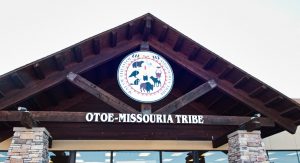

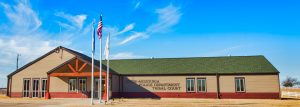
A moving Memorial to Veterans and Otoe Mothers stands near the Tribal Court Building.
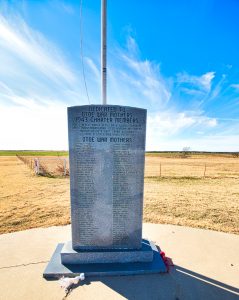
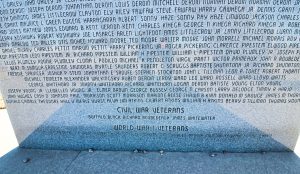
EARLY SETTLER HISTORY: THE OKLAHOMA AND CHEROKEE STRIP LANDRUSH
As a white woman, my ancestors arrived on the plains in the 1800s. My grandmother could actually remember living in a sod house in Norton, Kansas as a child. Another distant relative, a woman who had been abandoned by her husband in the 1800s, supported herself and children by running a boarding house for settlers near the border of the Oklahoma Territory.
On September 16, 1893, the largest land run in history began with more than 100,000 people pouring into the Cherokee Strip of Oklahoma to claim valuable land that had once belonged to Native Americans. The “sooner clause” in the Indian Appropriations Act of March 2, 1889, said that anyone who violated the official start would be denied a claim to the land.*******
With a single shot from a pistol the mad dash began, and land-hungry pioneers on horseback and in carriages raced forward to stake their claims to the best acres.* My own family lore tells of a distant relative who was at the starting line of the Landrush, only to lose a wagon wheel shortly after entering Oklahoma. Alas, no land was grabbed by my family.

With such a family history, I stopped at a small “Cherokee Strip Landrush Museum” just over the Kansas state line in Oklahoma.
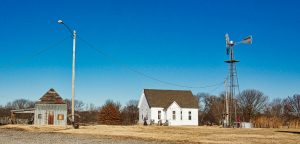
THE SETTLERS
Only 8 miles from the border with Kansas, I drove through one of the results of the land rush-the town of Newkirk. The first edition of the Newkirk Republican, which appeared on November 24, 1893, listed twenty-seven professionals and businesses, including two restaurants, four saloons, two meat markets, a lumberyard, and three banks. Within two months the community boasted 247 businesses. By 1901 the downtown area had twenty imposing stone structures, most of them built of native limestone quarried east of the community.********
The settling of Oklahoma Territory was evident as I drove through the town of Newkirk. The buildings in the historic downtown are architectural examples of the late 1800s and early 1900s.
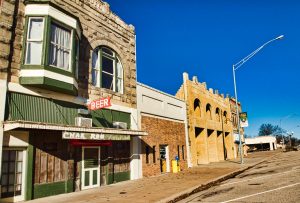
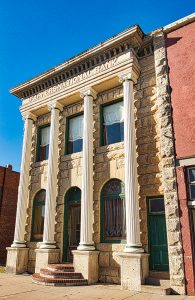

PIONEER WOMEN
Highway 177 takes you directly to Ponca City’s Pioneer Woman Museum and statue which are tributes to the bravery and accomplishments of the women who helped settle Oklahoma Territory.
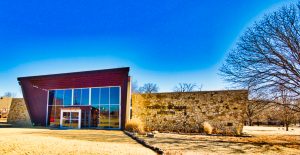
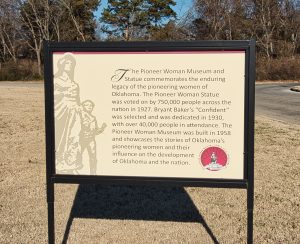
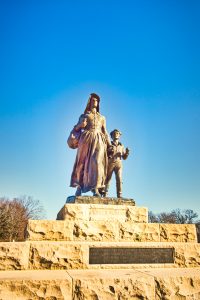
The Pioneer Woman is a heroic bronze statue of a young, sun-bonneted pioneer mother, protectively leading her son by the hand, striding confidently, head held high—a young woman of sturdy beauty and dignity whose eyes are fixed on the far southwestern horizon. Courage, determination, and humility are in her face. A bible is in her hand. The bronze cast is seventeen-feet high and weighs 12,000 pounds. The monument is thirty feel total in height. It was erected in 1930 at a cost of $300,000.***********
MODERN DAY OKLAHOMA
Soon after passing through Ponca City, the stark contrasts with early Oklahoma come into view. With oil wells in city parks and along the roads, Tulsa rises on the plains. Tulsa, with its own ballet and opera companies is every bit a sophisticated and modern American city.
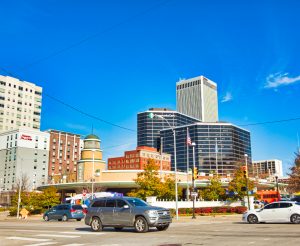
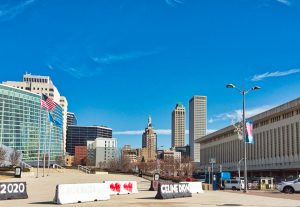
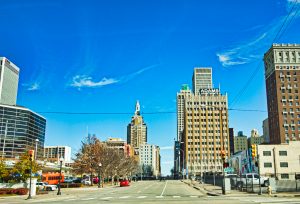
For me, the trip through a portion of Oklahoma was a reminder of the growth of America on the plains and the present day achievements in the state.
***ibid
****ibid
*****ibid
******ibid
*******https://www.okhistory.org/publications/enc/entry.php?entry=NE012
********https://www.pioneerwomanmuseum.com/learnmore.html
***********Oklahoma Historical Society